Phillip Noyce’s SALT takes audiences on a thrill ride with title character and CIA agent Angelina Jolie, who may or may not be a Russian spy out to assassinate the U.S. President. Visual effects supervisor Robert Grasmere oversaw the work of several vendors to provide hundreds of invisible shots for the film. We take a look at the effects by Framestore and CIS Vancouver.
Framestore aids in chases, locations and explosions
Framestore’s New York office was responsible for about 300 shots in Salt, its first major feature film project, under the supervision of Ivan Moran. The studio set up a Maya and Shake/Nuke pipeline and collaborated with artists based in the London and Iceland offices. For an initial Washington freeway chase seen as Salt escapes her CIA bosses after they suspect her of being a Russian spy, production shot in Albany in upstate New York. “Albany’s got quite a distinct skyline of skyscrapers because it’s the state capital,” said Moran. “It involved removing those buildings and replacing them with more distinctive landmarks like the Capital building and the Washington Monument.” Artists also carried out harness and wire removals for shots of Angelina Jolie atop a truck in the sequence.
Later, Framestore augmented a church procession sequence shot in Park Avenue in New York City, as mourners, including the U.S. and Russian Presidents, head to the funeral of the U.S. Vice President. “On the day they had bands and police cars and extras and so on,” recalled Moran, “but because a lot of the shots are very wide and you’re looking right down the street, it felt like there were probably 1000 people whereas Phillip Noyce wanted it to feel like there were more like 5000 people. So we did a lot of work integrating CG police cars, police bikes, band members and bystander crowds and secret service agents.”
Salt also makes her way to the funeral, via the subway. Filmed partly on a real subway and on a bluescreen set, Framestore combined footage of Angelina Jolie jumping off a train, landing on the ground and exiting to a place that turns out to be underneath the church altar. “The back plates were shot in a real subway tunnel with trains travelling past and real backgrounds,” said Moran. “Then there was a stunt where Angelina jumps off the train and lands on the ground and rolls out to an exit. That was again on bluescreen – we matched all the camera positions from the backplates that were shot and it was her moving into position on this little truck rig, jumping off and rolling to camera and we would cut her out and stick her on this subway background to make it look like she was coming off the train itself.”
“What we were able to do on set,” continued Moran, “was do a mixture of quick composites of the takes with a fairly sophisticated overlay system of live keying. As she came into view on the rig, we could actually see that overlaid on the background. With all that kind of action stuff, you tend to shoot it slightly overcranked and high speed. So there was a little bit of manipulation in post to make sure she sticks to the train and a little bit of ramp-up as she jumps off to make it feel more perilous. And we did a bit of work with the shadows.”
As the Russian President begins to deliver his eulogy at the church altar, Salt detonates charges underneath him, causing the floor to crumble and give way and making him fall into a knave below. Plates inside the church were shot at St Bartholomew’s in New York. A separate bluescreen shoot was used to film the actor on wires falling through a floor rig that dropped away. Framestore took high-res pictures of the intricate church floor patterns and reconstructed the crumbing ground in CG and added in the bluescreen actor. “We used Houdini for this effects work,” said Moran. “We pre-determined a pattern for the cracking to lace the geometry of the floor. In the areas where it cracked apart we could emit particles that we could do turn into geometry of various sizes. You could have little tiles, falling bits of dust or larger rocky clumpy bits all falling at the correct weight.” For shots looking up from Salt’s point of view, Framestore inserted additional falling debris and rock chunks.
Salt is then captured and taken into custody by police. But as she travels over the 59th Street bridge, hand-cuffed and inside an SUV, she orchestrates another escape by wrestling with the police, tasering them and finally driving the SUV off the bridge into taxi cabs below. Framestore added 3D taser prongs and wires and composited a complicated inside view of the vehicle going over the bridge, a stunt shot for real from multiple cameras. “In particular, they had a camera mounted looking out the windscreen,” noted Moran. “We matched that camera information in terms of lens and height in relation to the vehicle and built the interior of that SUV on a separate bluescreen stage where we had Angelina. We photographed her performing against the seats and the airbag as though she’s crashing into the taxi cab below, then did some sophisticated overlay compositing to check line-ups. Finally, we cut Angelina off the bluescreen, put her inside the car and added a lot of CG dust and debris to blend the shots together.”
At one point, a Russian agent infiltrates the White House and blows himself up as other agents open fire. Framestore added muzzle blasts and gun hits and damage to these scenes before the detonation. “Then the moment where he detonates we switch to a digi double,” said Moran. “We modelled the agent based on a scan and photographs taken on the day which we could blow apart. For ratings reasons, it had to look impressive and intense rather than gory and revolting – it was a compromise between how much you see and how much you don’t. We added smoke and fire elements ripping down the hallway as everyone is blown into the walls. We used CG fire coupled with elements we had shot and library elements, using Houdini to do particle elements. The moment he explodes the walls are blown apart and there was quite a bit of simulation on bits of wood and debris falling down.”
Framestore also completed effects involving muzzle flashes, bullet hits and monitor replacements for a fight sequence inside the White House bunker, where a confrontation between Salt and another Russian agent takes place. “At one point,” said Moran, “they’re standing on either side of bullet proof glass and the bullets fired end up being embedded in the glass. We modelled different types of bullets and had these in there with shards everywhere and smoke and debris. It also leaves this pattern in the glass and we had to repeat the pattern in all of the ensuing shots in the fight sequence.”
CIS builds the White House front and back
CIS Vancouver, which completed around 250 shots on Salt, was initially tasked with an establishing shot of the White House in Washington D.C. for the film “Obviously, production asked to see if they could shoot at the real location and were told flatly ‘No'”, recalled CIS Vancouver visual effects supervisor Mark Breakspear. “We thought about doing the White House environment as a matte painting, but that would have restricted some of the camera moves they were planning, so it was all done in 3D.” After the success of their initial White House work, production then asked Breakspear if they could do behind the building for later shots. “Well, we’d only built the front of course! But we were able to build that also as a CG environment, which was a really cool position to be in because no-one’s really ever filmed that close to the White House in that location before and we were able to deliver that via visual effects.”
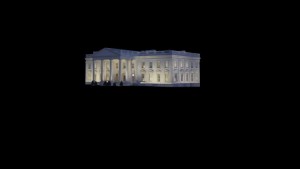
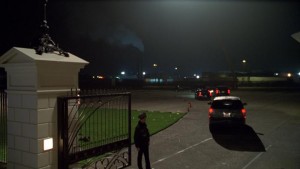
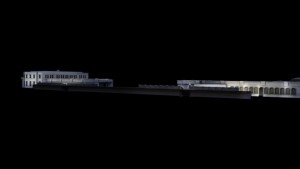
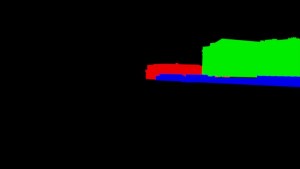
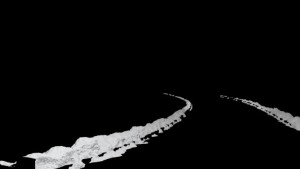
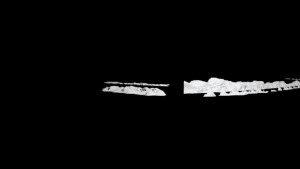
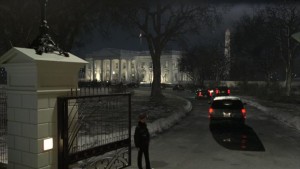
Representatives from CIS visited Washington D.C. on three occasions to acquire reference – over 30,000 photographs – of the White House and surrounding areas, initially for front views, then back views and later to accommodate the fact that it snowed during the principal shoot. “We wanted to get it at the right time of day and right time of year with all the right lighting permutations,” said Breakspear. “A location scout prepped the Secret Service for us to make sure it didn’t look suspicious turning up with 700mm lenses and all our equipment.”
CIS then looked to Google Earth’s 3D buildings feature as inspiration for how to populate the surrounding Washington areas so that the appropriate parallax shifts could be seen in the shots. “We wondered where Google was getting its data from and it turns out that it comes from a free government data set that you can download,” said Breakspear. “But, typical government, it was in some 3D format that no one has used since the 60s! God forbid if they ever wanted to use this in an emergency. Still, we took the data set and used it as a base to populate Washington with blocks of buildings and then textured them with projected textures from studies we had done.”
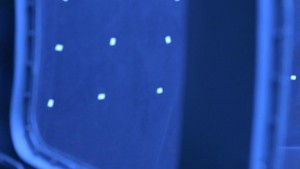
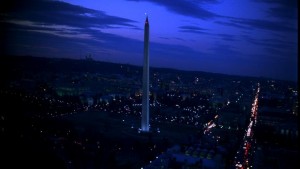
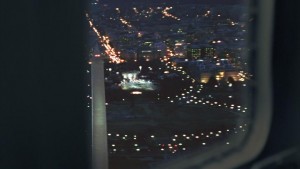
Using software that could take the 3D environment from the data set containing the boxes and convert them into buildings, CIS added windows based on certain patterns and box shape and height. “What we didn’t want to do was texture every single box by hand,” noted Breakspear. “The software could populate thousands of buildings off in the distance and we would texture the fix or six blocks around the White House in more detail.” CIS also built streets and automatically generated moving cars and firetrucks animated by the software’s brain. “You even see police cars coming up the road and other cars pulling over to allow them pass.”
Shots of the White House, seen from various angles and in helicopter-type moves, also included CG trees, people and atmosphere, all realised as if it had been shot for real with camera imperfections, wobbles, edge flares and exposure considerations. “The thing about the White House is,” said Breakspear, “if you’re getting the correct exposure on human skin, the White House blows out slightly because it’s lit so brightly and you’ve really got to stop down if you want to get the White House to blow out slightly on the correct exposure on film. So we allowed for all that to happen.”
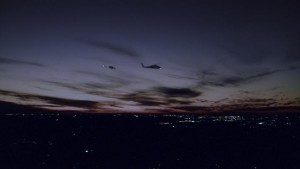
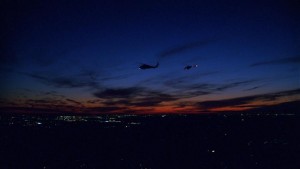
Elevating the elevator shaft
Inside the White House, Salt pursues the U.S. President down an elevator shaft to an underground secret bunker in a sequence enhanced with visual effects by CIS Vancouver. Production shot on a elevator set made up of three floors with Angelina Jolie and the camera operator on wires. “At the end of the day,” observed Breakspear, “some of the moves didn’t look quite as they wanted. “Hanging from a cable sometimes takes too much of the weight so that it doesn’t look like you’re free-falling. So we roto’d Angelina out of every single shot and re-built the entire elevator shaft in CG and re-designed the camera moves to up the drama.”
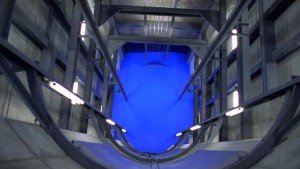
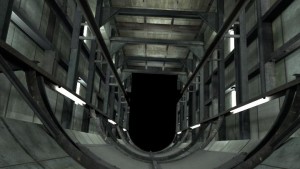
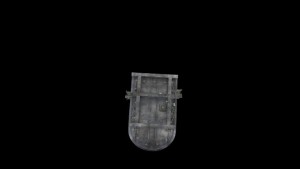
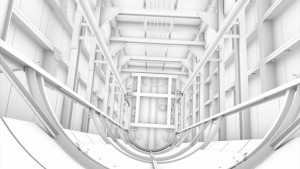
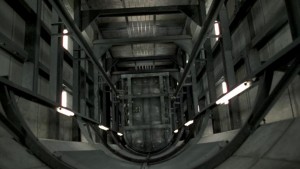
“First we did some previs tests to experiment with Angelina dropping more floors or adding in another twist in there,” added Breakspear, “so when she twists it look like she’s turning around. We weren’t building a CG version of her, but we thought, ‘What happens if she’s spinning and we make the camera spinning as well?’. We thought we could put that move back into the background.”
To re-build the elevator shaft, CIS enlisted the help of Skybucket’s Scott Cederleafv to perform a 3D scan that gave a dense 3D point cloud with colour and refection data for the whole environment. “Then we wrote some custom software to take that point data into Maya to allow us to do some custom building,” said Breakspear. “We used your typical boujou and pfTrack setup to do the tracking from the original plate, then took it into Maya and broke it all down and worked it all through to Nuke for compositing, which also let us import the 3D point cloud.”
For one shot of Salt seen above the camera as she turns around before jumping down another floor, the original footage was made more dynamic using CIS’ re-built elevator shaft. “In the original plate,” explained Breakspear, “she jumps across the shaft to the other side, then jumps down one floor. We had her instead jump down two floors and land, and when she turns around and jumps she goes down three floors. So we took a plate that was OK, but didn’t look very cool, and now all the floaty stuff has gone away because we extended how far she jumps and you get this feeling that she’s now actually in freefall as opposed to floating. If you jump from one place to another, you would accelerate and get a certain distance. But when you’re on a rope, that rope stops you accelerating and you don’t travel as far, but it looks like you’ve been in the air long enough to travel further. And that’s what it looked like.”
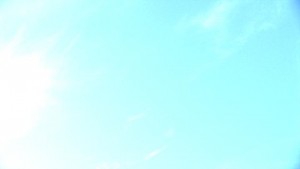
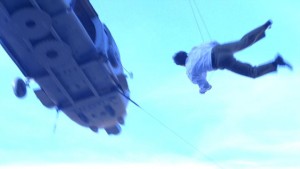
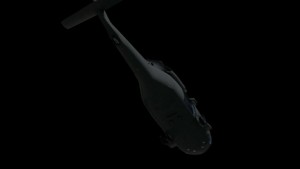
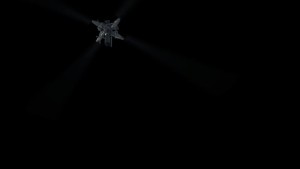
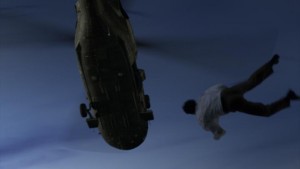
CIS also contributed bluescreen comps, wire removals, muzzle flashes, bullet hits and shots of Salt’s departure from the White House via helicopter. For one helicopter sequence, in particular, CIS’ CG team too advantage of the 3D capabilities in Nuke to realise the shot. “We’re below it looking up and seeing this person looking out of the chopper and it’s on a rig,” said Breakspear. “You could see the rig connected to the bottom of the chopper in the shot. So we had to add CG rotor blades and have a door come off with a model of the Black Hawks we’d made. We tracked the model in Nuke and we used the model and track to unwrap the helicopter and produce a UV. We then painted a new base onto the UV and re-wrapped it back up in comp. So we basically fixed, in 3D, the underside of the chopper in Nuke without even coming out of the software. Rather than have our comp team do that I got our CG team to do that in Nuke. I’d rather our CG team do CG things, although the cross-over now is pretty exciting.”
For Mark Breakspear, the spy plotline of the film not only closely resembled a recent embedded Russian spy controversy but also took on a certain personal security meaning during production. “There was one point on a weekend where I was at home in the garden working away and Robert Grasmere called me and the conversation went something along the lines of ‘Mark, it’s Robert. The higher ups need to talk to us about blowing up the White House and I need you to call me as soon as possible.’ He left that as a message – so can you just imagine the NSA suddenly seeing that pop up on their secret system! So I called him back and left a message saying, ‘Just for the record, now that you’re probably tapping our phone lines, we’re making a movie.'”
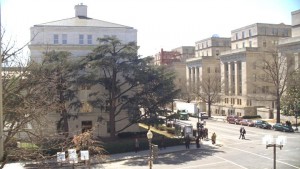
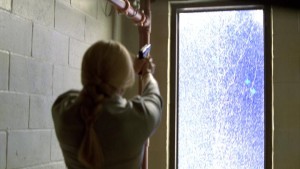
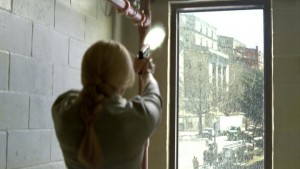
“At the same time, they had Fed-Exed us some props from the movie including a missile that we were putting into a shot and hand-cuffs. This is right before the Winter Olympics in Vancouver and CIS is right opposite the Olympic Village. So I get a package which actually said ‘missile and hand-cuffs’ on it and then a week later the police turn up wanting to interview me! Anyway, I’m probably on the flying blacklist now…”
